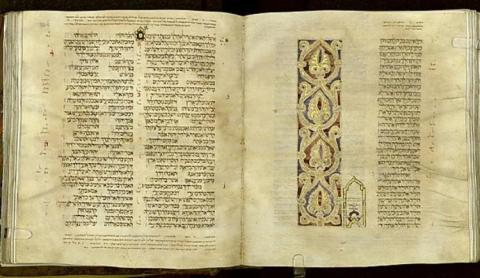All the World's Hebrew Manuscripts Online
The National Library already has some 85,000 Hebrew manuscripts from 40 countries, which were collected over the past few decades by Israeli researchers, including many from the National Library itself. Of these, some 10,000 are original documents kept in the library, while the rest are copies or microfilm versions stored elsewhere. So far, the new website has uploaded about 45,000 of them. The library’s collection includes some 4 million photographs of the manuscript pages. Stollman estimates it will take up to two years to complete the scanning and make the entire collection accessible online.
Experts say that thousands more Hebrew manuscripts exist around the world, and in Israel too, that are not yet in the library’s hands. Some estimate the number to be 15,000, many of whichare in private hands. “Many people from Yemen keep a manuscript their grandfather copied,” says Stollman as an example.
In 1950, the Institute of Hebrew Manuscripts was established as part of the Education Ministry to store copies of all Hebrew manuscripts. Prof. Nehemiah Allony, the first director of the institute and an expert in Hebrew manuscripts, traveled the world to visit libraries, including the Vatican and others in Germany, Austria, Hungary, France and the Low Countries, bringing back thousands of microfilmed manuscripts. In 1963, the institute moved to the Jewish National and University Library, the predecessor of the National Library, and changed its name to the Institute of Microfilmed Hebrew Manuscripts. The collection of manuscripts continued growing over the years.
Today the library is finally fulfilling the dream of Israel’s founder and first prime minister, David Ben-Gurion — a dream Stollman calls “ingenious and a breakthrough as far as research is concerned. Now we are completing this breakthrough by uploading this material to the internet,” he adds. The manuscripts in the Ktiv collection were scanned from the originals or from high-resolution microfilm copies. The digital version of Ben-Gurion’s vision is intended to be used for academic research as well as cultural and religious enrichment.
Many of the library’s manuscripts are hundreds of years old and cover a wide range of topics, including the Bible, philosophy, astronomy, sciences, kabbala, literature, medicine and the Jewish calendar. The collection includes scans of commercial and family documents from 11th century Afghanistan, 13th century manuscripts revealing the internal conflicts within the Yemenite Jewish community, a manuscript of the Babylonian Talmud from the 14th Century and one written by Rabbi Joseph Caro, the author of the Shulhan Arukh, in his own hand. The manuscripts are written in Hebrew letters in a wide range of Jewish languages, such as Yiddish, Ladino, Judeo-Arabic and Judeo-Greek. The collection does not contain any printed items, only hand-written ones.
Many manuscripts, which are not part of the collection, have disappeared over the years. “Very few were saved from the Middle Ages. Throughout that time they burned the Jews’ manuscripts,” says Stollman.
In addition to digitizing and placing its collection online, the library has also started a campaign to expand its collection through cooperative agreements with other institutions around the world that have such manuscripts.
“The Hebrew manuscripts, which reflect the knowledge and culture of the Jewish people, have wandered all over lands and continents until in the end they found shelter in large libraries and the safes of private collections. In our time, these manuscripts are a rich source of information on the spiritual and material culture of the Jewish communities around the world, and now we are enabling free access to all Hebrew manuscripts from the computer and mobile device,” says David Blumberg, the chairman of the National Library.
Ktiv is a joint project of the National Library and the Friedberg Jewish Manuscript Society, with support from the Landmarks Project of the Ministry of Jerusalem Affairs and Heritage. Among the other libraries and institutions that are participating in the project are the Ben-Zvi Institute, the Jewish Theological Seminary, the New York Public Library, the British Library, the Columbia University Library and the national libraries of Austria, France and Russia.
Ofer Aderet

